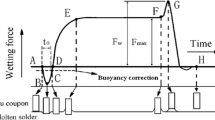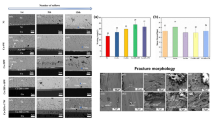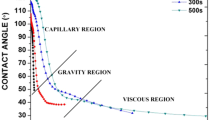Abstract
Fluxes have a negative impact on the environment; as a result, fluxless soldering has become a promising method in electronic packaging. However, detailed studies on fluxless soldering are very rare, especially those involving the use of electroless nickel immersion gold (ENIG) substrate under formic acid (FA) atmosphere that can effectively reduce the majority of solders. In this work, the characteristic parameters of FA reflow soldering performed by combining Sn–3.5Ag–0.5Cu (SAC305) solder and ENIG substrate are compared with the soldering conducted using liquid rosin mildly activated (RMA) flux. It is found that the wettability of FA-exposed solder is greater than that of RMA-containing solder because the former spreads across the interfacial layer of intermetallic compounds (IMCs) produced before the melting of SAC305. Additionally, the interfacial reactions of FA-exposed solder resemble those of RMA solder before and after the thermal aging at 150 °C. Therefore, the impact strengths of these two solders are almost the same due to the similarity of their microstructures and close growth rates of (Cu,Ni)6Sn5 IMC layers during thermal aging. The findings of this study suggest that FA reflow soldering is a promising environmentally friendly technique for electronic packaging.













Similar content being viewed by others
References
Kotadia HR, Howes PD, Mannan SH (2014) A review: on the development of low melting temperature Pb-free solders. Microelectron Reliab 54:1253–1273
Lee N-C (1999) Lead-free soldering-where the world is going. Adv Microelectron 26:29
Kang SK, Sarkhel AK (1994) Lead (Pb)-free solders for electronic packaging. J Electron Mater 23:701–707
Wood E, Nimmo K (1994) In search of new lead-free electronic solders. J Electron Mater 23:709–713
Suganuma K (2001) Advances in lead-free electronics soldering. Curr Opin Solid State Mater Sci 5:55–64
Shen Y-A, Chen C (2017) Effect of Sn grain orientation on formation of Cu6Sn5 intermetallic compounds during electromigration. Scripta Mater 128:6–9
He S, Nishikawa H (2017) Effect of substrate metallization on the impact strength of Sn–Ag–Cu solder bumps fabricated in a formic acid atmosphere. In: International conference on electronics packaging (ICEP) (IEEE), pp 381–385
Hanss A, Hutter M, Trodler J, Elger G (2016) In: Electronic components and technology conference (ECTC), 2016 IEEE 66th (IEEE), pp 447–454
Bušek D et al (2016) Flux effect on void quantity and size in soldered joints. Microelectron Reliab 60:135–140
Lin W, Lee Y (1999) Study of fluxless soldering using formic acid vapor. IEEE Trans Adv Packag 22:592–601
Lu Q-B, Sanche L (2001) Effects of cosmic rays on atmospheric chlorofluorocarbon dissociation and ozone depletion. Phys Rev Lett 87:078501
Samson M et al (2016) In: 2016 IEEE 66th electronic components and technology conference (ECTC) (IEEE), pp 574–579
Dušek K, Bušek D (2016) Problem with no-clean flux spattering on in-circuit testing pads diagnosed by EDS analysis. Microelectron Reliab 56:162–169
Hanss A, Schmid M, Bhogaraju SK, Conti F, Elger G (2018) In: 2018 International conference on electronics packaging and iMAPS all Asia conference (ICEP-IAAC) (IEEE), pp 479–484
Hanss A, Elger G (2018) Residual free solder process for fluxless solder pastes. Solder Surf Mt Technol 30:118–128
Koleňák R, Kostolný I, Drápala J, Sahul M, Urminský J (2018) Characterizing the soldering alloy type In–Ag–Ti and the study of direct soldering of SiC ceramics and copper. Metals 8:274–291
Koleňák R, Kostolný I, Kusý M (2018) Characterization of soldering alloy type Zn–In–Mg and the study of direct soldering of silicon and copper. Mater Sci Eng A 712:302–312
Hong S-M, Kang C-S, Jung J-P (2002) Fluxless Sn-3.5 mass% Ag solder bump flip chip bonding by ultrasonic wave. Mater Trans 43:1336–1340
Nishikawa T et al (1999) In: 1994 Proceedings of 44th electronic components and technology conference (IEEE), pp 286–292
Koopman N, Bobbio S, Nangalia S, Bousaba J, Piekarski B (1993) In: Proceedings of IEEE 43rd electronic components and technology conference (ECTC’93) (IEEE), pp 595–605
Lee CC, Chen Y-C, Matijasevic G, Metzler R (1994) In: 1994 Proceedings of 44th electronic components and technology conference (IEEE), pp 595–599
Humpston G, Jacobson DM (2004) Principles of soldering. ASM International, Cleveland
Dong C, Arslenian G (1996) Fluxless soldering of flip chip assemblies. Nepcon West, pp 96–112
Dong CC, Schwarz A, Roth DV (1997) Feasibility of fluxless reflow of lead-free solders in hydrogen and forming gas. Nepcon Malays 97:03–32
Monta M, Okiyama K, Sakai T, Imaizumi N (2012) In: 2012 IEEE 14th electronics packaging technology conference (EPTC) (IEEE), pp 602–607
Cheng S, Huang C-M, Pecht M (2017) A review of lead-free solders for electronics applications. Microelectron Reliab 75:77–95
Lu D, Wong C (2009) Materials for advanced packaging, vol 181. Springer, New York
Zhang S, Zhang Y, Wang H (2009) Effect of oxide thickness of solder powders on the coalescence of SnAgCu lead-free solder pastes. J Alloys Compd 487:682–686
Chang H, Chen H, Li M, Wang L, Fu Y (2009) Generation of Tin (II) oxide crystals on lead-free solder joints in deionized water. J Electron Mater 38:2170–2178
Batzill M, Diebold U (2005) The surface and materials science of tin oxide. Prog Surf Sci 79:47–154
Siliang H, Hiroshi N (2017) Effect of thermal aging on the impact strength of soldered bumps under formic acid atmosphere. Q J Jpn Weld Soc 35:127s–131s
Yoon J-W, Jung S-B (2005) Interfacial reactions between Sn–0.4 Cu solder and Cu substrate with or without ENIG plating layer during reflow reaction. J Alloys Compd 396:122–127
Liu X, Nishikawa H (2017) Pressureless sintering bonding using hybrid microscale Cu particle paste on ENIG, pure Cu and pre-oxidized Cu substrate by an oxidation–reduction process. J Mater Sci: Mater Electron 28:5554–5561
Lee H et al (2018) Effect of solder resist dissolution on the joint reliability of ENIG surface and Sn–Ag–Cu solder. Microelectron Reliab 87:75–80
Date M, Shoji T, Fujiyoshi M, Sato K, Tu K (2004) Ductile-to-brittle transition in Sn–Zn solder joints measured by impact test. Scripta Mater 51:641–645
Wang J, Nishikawa H (2014) Impact strength of Sn–3.0 Ag–0.5 Cu solder bumps during isothermal aging. Microelectron Reliab 54:1583–1591
Shen Y-A, Lin C-M, Li J, He S, Nishikawa H (2019) Effect of FeCoNiCrCu 0.5 high-entropy-alloy Substrate on Sn grain size in Sn–3.0 Ag–0.5 Cu solder. Sci Rep 9:3658–3664
Shen Y-A, Ouyang F-Y, Chen C (2019) Effect of Sn grain orientation on growth of Cu–Sn intermetallic compounds during thermomigration in Cu–Sn2. 3Ag–Ni microbumps. Mater Lett 236:190–193
Matsumoto T, Nogi K (2008) Wetting in soldering and microelectronics. Annu Rev Mater Res 38:251–273
Suganuma K, Niihara K, Shoutoku T, Nakamura Y (1998) Wetting and interface microstructure between Sn–Zn binary alloys and Cu. J Mater Res 13:2859–2865
Lee JH, Lee DN (2001) Use of thermodynamic data to calculate surface tension and viscosity of Sn-based soldering alloy systems. J Electron Mater 30:1112–1119
Zhao N, Pan X, Yu D, Ma H, Wang L (2009) Viscosity and surface tension of liquid Sn–Cu lead-free solders. J Electron Mater 38:828–833
Kim P, Tu K (1996) Morphology of wetting reaction of eutectic SnPb solder on Au foils. J Appl Phys 80:3822–3827
Conti F, Hanss A, Mokhtari O, Bhogaraju SK, Elger G (2018) Formation of tin-based crystals from SnAgCu alloy under formic acid vapor. New J Chem 42:19232–19236
Mokhtari O et al (2019) Characterization of tin-oxides and tin-formate crystals obtained from SnAgCu solder alloy under formic acid vapor. New J Chem 43:10227–10231
Conti F, Hanss A, Fischer C, Elger G (2016) Thermogravimetric investigation on the interaction of formic acid with solder joint materials. New J Chem 40:10482–10487
He S, Gao R, Li J, Shen Y-A, Nishikawa H (2019) In-situ observation of fluxless soldering of Sn–3.0Ag–0.5Cu/Cu under a formic acid atmosphere. Mater Chem Phys. https://doi.org/10.1016/j.matchemphys.2019.122309
Yoon J-W, Noh B-I, Jung S-B (2010) Effects of third element and surface finish on interfacial reactions of Sn–Ag–xCu (or Ni)/(Cu or ENIG) solder joints. J Alloys Compd 506:331–337
Kumar G, Prabhu KN (2007) Review of non-reactive and reactive wetting of liquids on surfaces. Adv Coll Interface Sci 133:61–89
Lin Q, Li F, Wang J (2018) Wetting of Sn/Cu and Sn/Cu–Sn IMCs at 623–723K. J Alloys Compd 767:877–882
Eustathopoulos N (2005) Progress in understanding and modeling reactive wetting of metals on ceramics. Curr Opin Solid State Mater Sci 9:152–160
Liu C, Kim H, Tu K, Totta P (1996) Dewetting of molten Sn on Au/Cu/Cr thin-film metallization. Appl Phys Lett 69:4014–4016
Wang H, Zhao H, Sekulic DP, Qian Y (2008) A comparative study of reactive wetting of lead and lead-free solders on Cu and (Cu6 Sn5/Cu3 Sn)/Cu substrates. J Electron Mater 37:1640–1647
Liashenko O, Hodaj F (2017) Wetting and spreading kinetics of liquid Sn on Ag and Ag3Sn substrates. Scripta Mater 127:24–28
He B, Lee J, Patankar NA (2004) Contact angle hysteresis on rough hydrophobic surfaces. Colloids Surf A 248:101–104
Chen Y, He B, Lee J, Patankar NA (2005) Anisotropy in the wetting of rough surfaces. J Colloid Interface Sci 281:458–464
Quéré D (2002) Rough ideas on wetting. Physica A 313:32–46
Nakae H, Inui R, Hirata Y, Saito H (1998) Effects of surface roughness on wettability. Acta Mater 46:2313–2318
Kim K, Huh S, Suganuma K (2003) Effects of intermetallic compounds on properties of Sn–Ag–Cu lead-free soldered joints. J Alloys Compd 352:226–236
Kim D, Pak JJ (2010) Micro void growth in NiSnP layer between (Cu,Ni)6 Sn5 intermetallic compound and Ni3 P by higher reflow temperature and multiple reflow. J Mater Sci: Mater Electron 21:1337–1345
Hung K, Chan Y, Tang C, Ong H (2000) Correlation between Ni3 Sn4 intermetallics and Ni3 P due to solder reaction-assisted crystallization of electroless Ni–P metallization in advanced packages. J Mater Res 15:2534–2539
Hung K, Chan Y, Tang C (2000) Metallurgical reaction and mechanical strength of electroless Ni–P solder joints for advanced packaging applications. J Mater Sci: Mater Electron 11:587–593
Acknowledgements
The authors would like to acknowledge SANYOSEIKO, LTD (Japan) for the financial support of this study.
Funding
This study was funded by the Project to Create Research and Educational Hubs for Innovative Manufacturing in Asia, Osaka University under the Special Project of the Ministry of Education, Culture, Sports, Science and Technology (MEXT).
Author information
Authors and Affiliations
Corresponding author
Ethics declarations
Conflict of interest
The authors declare that they have no conflicts of interest.
Additional information
Publisher's Note
Springer Nature remains neutral with regard to jurisdictional claims in published maps and institutional affiliations.
Rights and permissions
About this article
Cite this article
He, S., Gao, R., Shen, YA. et al. Wettability, interfacial reactions, and impact strength of Sn–3.0Ag–0.5Cu solder/ENIG substrate used for fluxless soldering under formic acid atmosphere. J Mater Sci 55, 3107–3117 (2020). https://doi.org/10.1007/s10853-019-04153-9
Received:
Accepted:
Published:
Issue Date:
DOI: https://doi.org/10.1007/s10853-019-04153-9




